【Model Course for Sightseeing around Kiyomizu-Dera Temple】 Kyoto, Japan

Kyoto is the pride of Japan’s tourist city. Among them, many of Kyoto’s popular sightseeing and worship spots, such as Kiyomizu Temple, Kodaiji Temple, Yasaka Shrine, Nichinenzaka and Sannenzaka, are located in the Higashiyama neighborhood. However, since the area is very touristy, advance preparation is essential.
Therefore, we would like to introduce the following three model sightseeing courses centering on the “8 standard and popular spots” in and around Kiyomizu-Dera Temple and its surroundings, with photos, so that you can enjoy sightseeing in an efficient manner.
■Model course for “early morning sightseeing” to visit all 8 popular spots around Kiyomizu Temple in a comfortable manner.
Time required: about 6 hours
■A shortened version of a model sightseeing course for busy people in and around Kiyomizu-dera Temple.
Time required: about 3 hours
■Eating and walking on Nichinenzaka and Sannenzaka
Time required: about 4 to 5 hours
Model Tour of Kiyomizu-Dera Temple and 8 surrounding spots】
Duration: about 6 hours
(1) Pray for good fortune at Yasui Kompira-gu Shrine
(2) Take a commemorative photo at Hokanji Temple (Yasaka-no-to)
(*This course includes only photo shooting.)
(3) Take a commemorative photo at Nichinenzaka and Sannenzaka
(4)Sightseeing to your heart’s content at Kiyomizu Temple
< Breakfast at Starbucks or Maeda Coffee on Ninenzaka>
(5) Pray for a monkey at Kongoji Temple (Yasaka Koshindo)
(6)Walk around the beautiful precincts of Kodaiji Temple
(7) Experience Zen training at Entokuin Temple
(8) Visit Kenninji Temple to see the powerful “Double Dragon Head” and the National Treasure “The Wind and Thunder Gods
Even the crowded Kiyomizu-dera area can be comfortably visited in the early morning!
Although the Kiyomizu-dera area is famous for its large crowds, Kiyomizu-dera can actually be visited from 6:00 AM. I recommend sightseeing from 6:00 to 8:00 a.m., as there are very few group tourists.
Therefore, I will fill in the schedule with “early morning sightseeing ” that I recommend.
By heading there early in the morning and “visiting each popular sightseeing spot at the start of the sightseeing hours”, you will be able to enjoy comfortable sightseeing without crowds.
(If early morning sightseeing is difficult, it is recommended to go in the opposite direction of the listed course or to visit Kiyomizu Temple in the evening (from around 4:30 p.m.) to avoid the crowds.)
<Start time for sightseeing: 6:30 AM>
If you want to fully enjoy Kiyomizu-Dera Temple, early morning is definitely recommended as it is less crowded!
Take city bus No. 206 fromKyoto Stationand get off atHigashiyama Yasui ( it is important to get off at Higashiyama Yasui, not Kiyomizu-michi ) .
Or, from Keihan Gion-Shijo Station, walk 10-15 minutes to Yasui Konpira-gu Shrine to start sightseeing.
※Routes ① to ④ starting from Gion Shijo
① Pray for good fortune and marriage at Yasui Konpira-gu Shrine
This shrine is famous for its Enmikiri and Engi-Musubi (match-making) monuments. Let’s enjoy your trip to Kyoto to cut off bad relationships and refresh yourself for a good marriage.
<Arrival time: 6:40 AM → End time: 6:50 AM / Duration: 10 minutes>
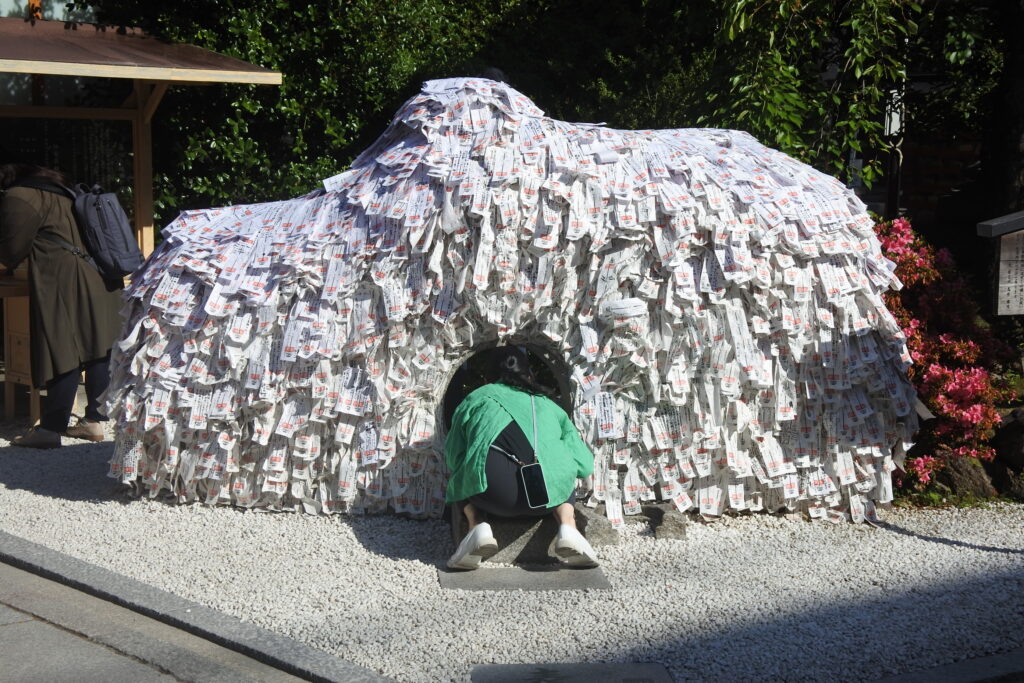
Yasui Konpira-gu Shrine is actually open 24 hours a day for worshipand for prayers at the “Enkiri Enmusubi Monument,” and the temple grounds can be visited all day long. Like Kiyomizu-dera Temple, it is a very popular place and tends to get crowded as noon approaches, so be sure to get there first thing in the morning to complete your prayers quickly.
<About Yasui Konpiragu Shrine>
The main deity is the Emperor Shotoku, and the shrine offers prayers for good marriages and for the severance of all bad marriages, including those between a man and a woman, as well as those between a man and a woman, and those between a man and a woman, and those between a man and a woman, as well as those between a man and a woman, and those between a man and a woman. Couples who have been united in a good marriage can visit the shrine and receive the blessing of a deeper and stronger bond between the couple.
To pray, first visit the main shrine, then write your wish on a “katashiro” (a paper tablet), and while holding the tablet, go through the hole from the front to the back of the monument with your wish in mind. Then, while holding the “katashiro” and thinking of your wish, walk through the hole from the front to the back of the monument, first to cut off bad relationships, and then to tie good relationships by walking from the back to the front. Finally, a “katashiro” is affixed to the monument. It is also beneficial for maritime safety and traffic safety. Why don’t you pray for a safe trip to Kyoto and a good encounter?
<Yasui Konpiragu Shrine: Basic Information.>
Cost : Admission and worship are free. Prayer cards: 100 yen
Hours: All day (visitation is also possible 24 hours a day)
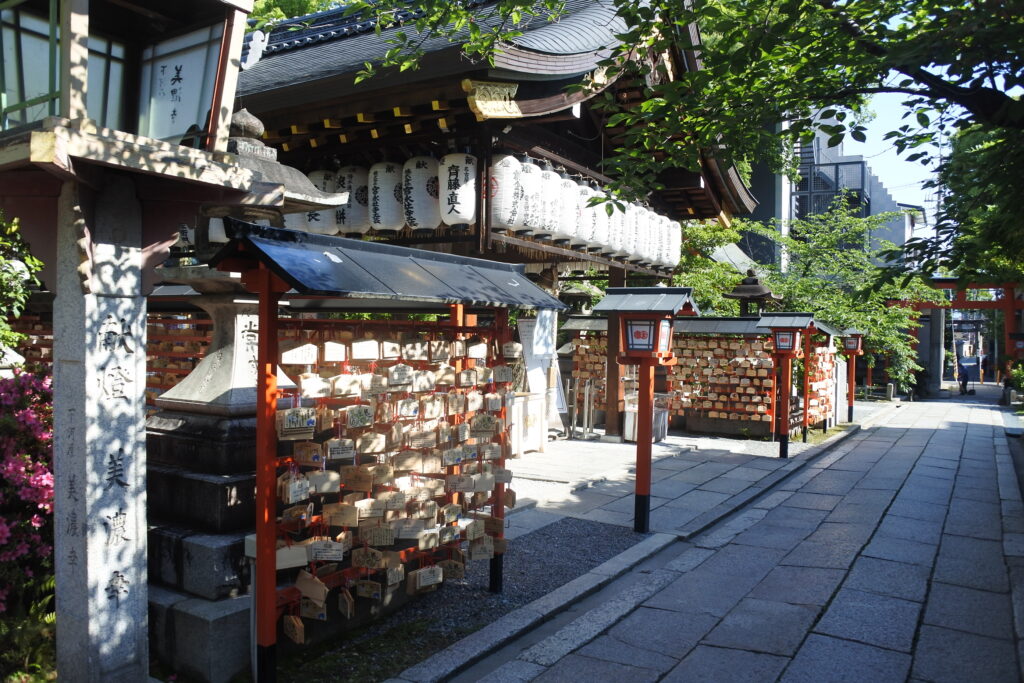

②Commemorative photo at Hokanji Temple (Yasaka-tower)
A landmark in Higashiyama, Kyoto. Popular photo spot Hokanji Temple (Yasaka-no-to)
<Arrival time: 6:55 AM → End time: 7:05 AM / Duration: 10 minutes
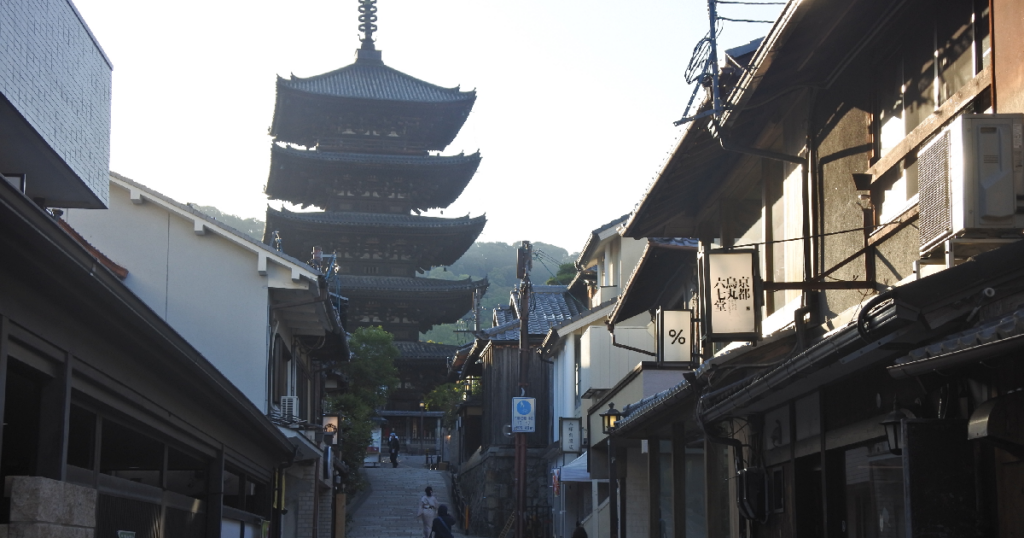
From Yasui Konpiragu Shrine, cross the street at the traffic light and walk about 5 minutes to reach Yasaka-dori Avenue. From here comes Hokanji Temple (Yasaka-no-to), which is famous in brochures. This is also a popular photo spot, so be sure to finish taking commemorative photos and Instagram shots while there are no people around.
*Hokanji Temple is open for viewing from 10:00 am. If you wish to see the temple, head there on your way back from Kiyomizu-dera Temple.
<About Hokanji Temple (Yasaka-tower)>
Located exactly halfway between Yasaka Shrine and Kiyomizu Temple, this temple belongs to the Kenninji School of the Rinzai sect of Zen Buddhism. Founded in the Asuka Period (589), Hokanji Temple is said to be the oldest temple in the ancient capital of Kyoto. According to temple legend, Prince Shotoku built the five-storied pagoda and stored the relics of Buddha in it after a dream by Nyoirin Kannon (Goddess of Mercy).
The five-story, 46-meter-high pagoda is a purely Japanese-style structure with a tile roof, and as one of the four five-story pagodas in Kyoto City, it is a landmark representing the Higashiyama area. Since its construction, the pagoda has often been destroyed by fire, but each time it was rebuilt, and the current pagoda was rebuilt in 1440. Inside the pagoda are five statues of Nyorai Buddha and many other valuable cultural assets. The most famous photo opportunities are from Yasaka-dori Avenue and from the road coming down Nichinen-zaka and Sannen-zaka slopes. We hope you will enjoy the spectacular view.
Hokanji Temple (Yasaka-no-to): Basic Information
Cost: Free for photography / 400 yen for visit (10:00-15:00)


③Commemorative photo at Ninenzaka (Nineizaka) and Sannenzaka (Sanneizaka)
Nichinenzaka and Sannenzakaare also very popular photo spots. You can take as many photos as you like on the slopes of Nichinenzaka and Sannenzaka.
<Arrival time: 7:10 AM → End time: 7:20 AM / Duration: 10 minutes>.

Going straight down Yasaka Dori, you will join the road leading to Nigenzaka and Sannenzaka with their beautiful Kyoto machiya houses and cobblestone pavements. This is also a popular photo spot, but it is sparsely populated in the early morning. Take your commemorative photo early in the morning while there are still a few people around!
④Sightseeing to your heart’s content at Kiyomizu-dera Temple
Sightseeing at Kiyomizu Temple, one of the most famous temples in Japan, dotted with national treasures and important cultural materials, without any hesitation.
<Arrival time: 7:25 AM → End time: 8:15 AM / Duration: 50 minutes>.

Kiyomizu-dera Temple can be reached from Ninen-zaka and Sannen-zaka in about 5 minutes with few people if it is early in the morning. Kiyomizu-dera Temple is actually open for viewing from 6:00 a.m., and the temple grounds are sparsely populated between 6:00 and 8:00 a.m. You can sightsee comfortably without the huge crowds that are reported on TV.
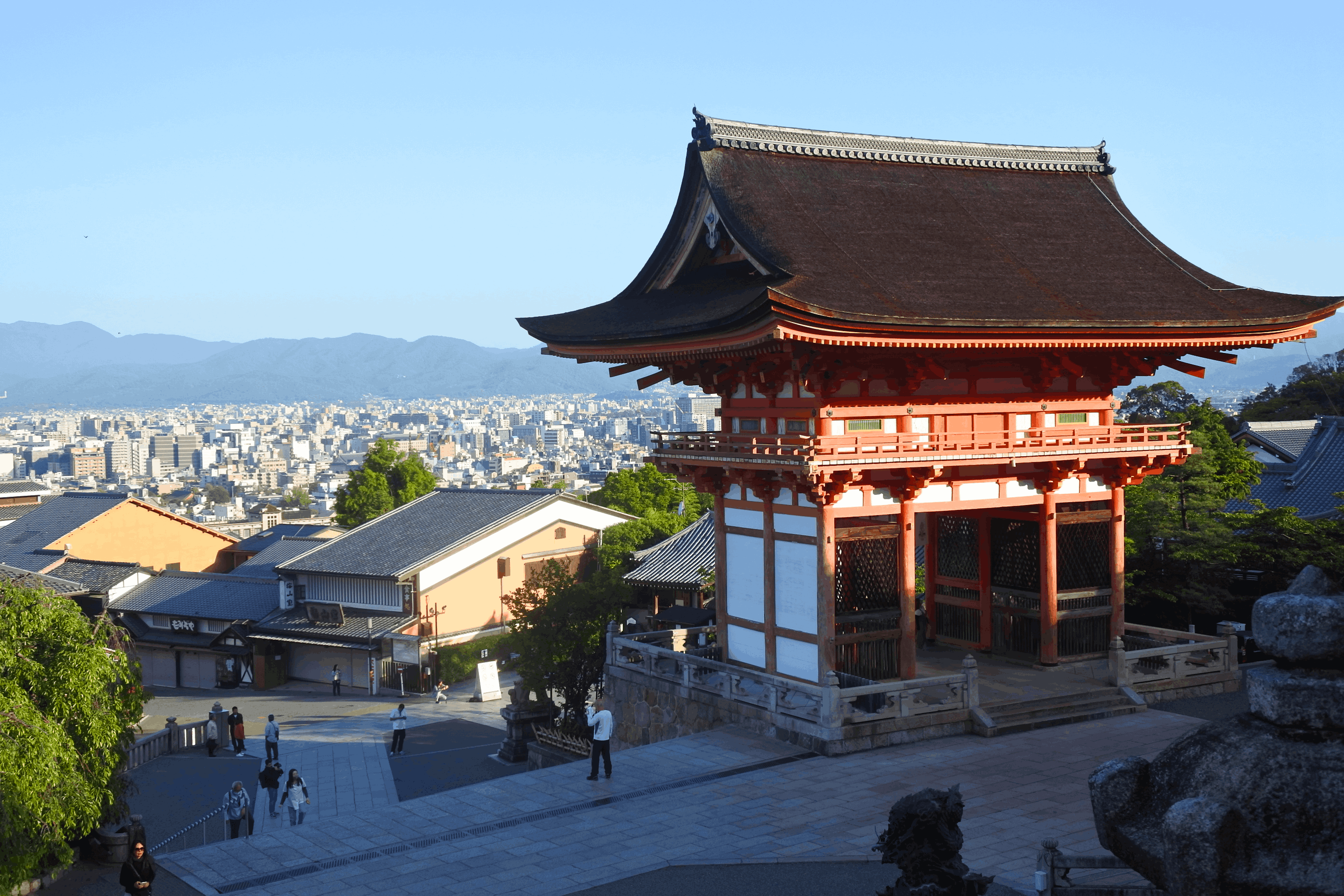


<About Kiyomizu Temple>
Kiyomizu-Dera Temple, located on Mount Otowa, is said to attract more than 5 million visitors annually and is known as a World Heritage Site representing not only Kyoto but also Japan. In addition to the main hall, which is a national treasure, the temple grounds are lined with many important cultural properties, and the beautiful autumn leaves and panoramic view of Kyoto have attracted many visitors from Japan and abroad, regardless of age. Kiyomizu-dera Temple was originally believed to be a sacred place where people pray to the Kannon (Goddess of Mercy ) for blessings in this life, such as good health, success in life, and good marriage. The panoramic view of Kyoto from the famous Kiyomizu stage and the inner sanctuary is breathtaking.
<Kiyomizu Temple: Basic Information>
Admission: 500 yen
Hours: 6:00 – 18:00
④Route from Kiyomizu Temple to ⑦ Entokuin Temple
⑧ Route from Entokuin to ⑧ Kenninji Temple
Break:
Breakfast at Starbucks Coffee Kyoto Niningsaka Yasaka Chaya or Maeda Coffee Kodaiji
After leaving Kiyomizu-dera Temple, take a break until the next destination, Kongoji Temple (Yasaka Koshindo), opens its gates. Return to Ninenzaka and have breakfast at a popular coffee chain that has renovated an old private house. After a break and a full stomach, you are ready for your next sightseeing tour.
<Arrival time: 8:20 AM → End time: 8:50 AM / Duration: 30 minutes>.

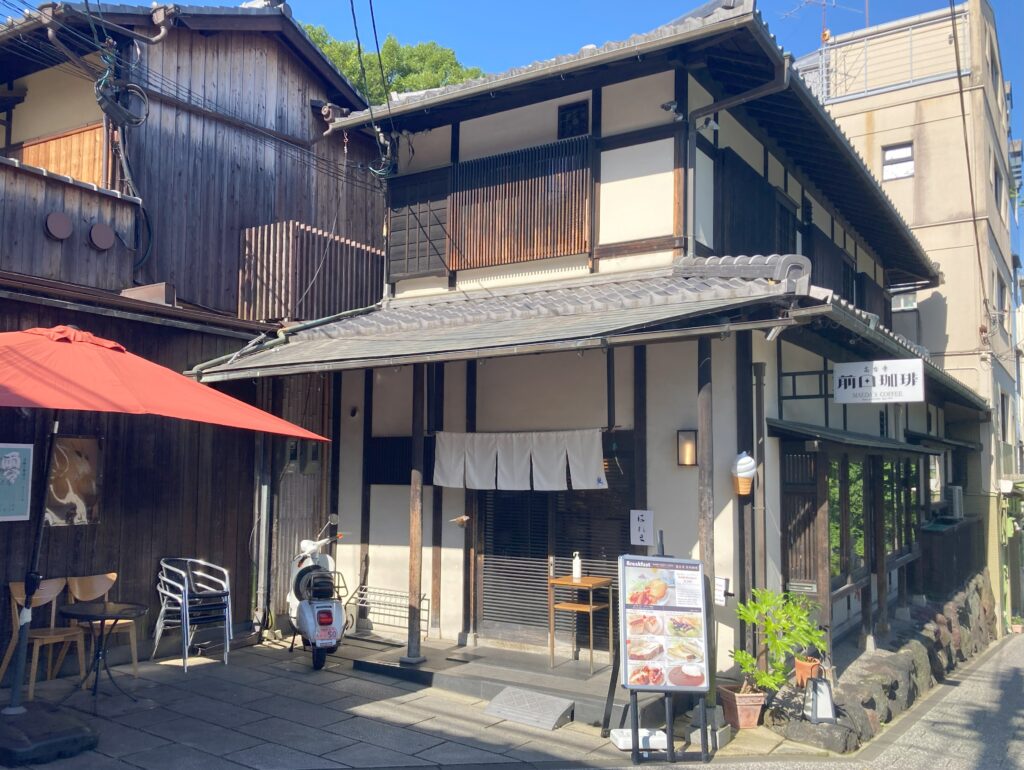
Take a break at this popular coffee chain’s Kyoto-style store in a traditional Japanese-style house. The interior is Japanese style, so you can enjoy not only with your stomach but also with your eyes.
Maeda Coffee Kodaiji branch opens at 7:00 AM.
Maeda Coffee Koudaiji is open from 7:00 a.m. and offers a wide variety of breakfast items for those who want to eat well. Terrace seating is also available. Walk through Nichinenzaka and head in the direction of Kodaiji Temple to get there.
Starbucks Kyoto Ninenzaka Yasaka Tea House opens at 8:00 AM.
It is very popular and people are lined up even before it opens. If you want to enjoy yourself inside the store, there are only a few seats, so it is best to get in line 10 to 15 minutes before the store opens. Seats are located on the second floor.
⑤Kuguri Monkey Prayer Experience at Kongoji Temple (Yasaka Koshindo)
Kongoji Temple (also known as Yasaka Koshindo) is a hot spot on SNS for its colorful “kukuri monkeys.
<Arrival time: 9:00 AM → End time: 9:15 AM / Duration: 15 minutes

You can visit the temple from 9 AM, so you can avoid the crowds if you visit Kiyomizu Temple in the morning or after breakfast. The temple grounds are very small, so the time required is short.
<About Kongoji Temple (Yasaka Koshindo)>
Yasaka Koshindo has long been a favorite prayer hall in Kyoto, where people pray to the Koshindo for the fulfillment of various wishes, including healing of illnesses, protection from calamities, and marriage. The “Kukuri Saroo” is especially famous for its wish-fulfillment ceremony in which you write down your wish and entrust it to a monkey, the messenger of the main deity, Seimen Kongo, who will deliver your wish. You can choose from red, blue, or yellow for each monkey, or five monkeys in a row. Statues of “see no evil, speak no evil, hear no evil” monkeys and other messengers can be seen everywhere on the temple grounds.
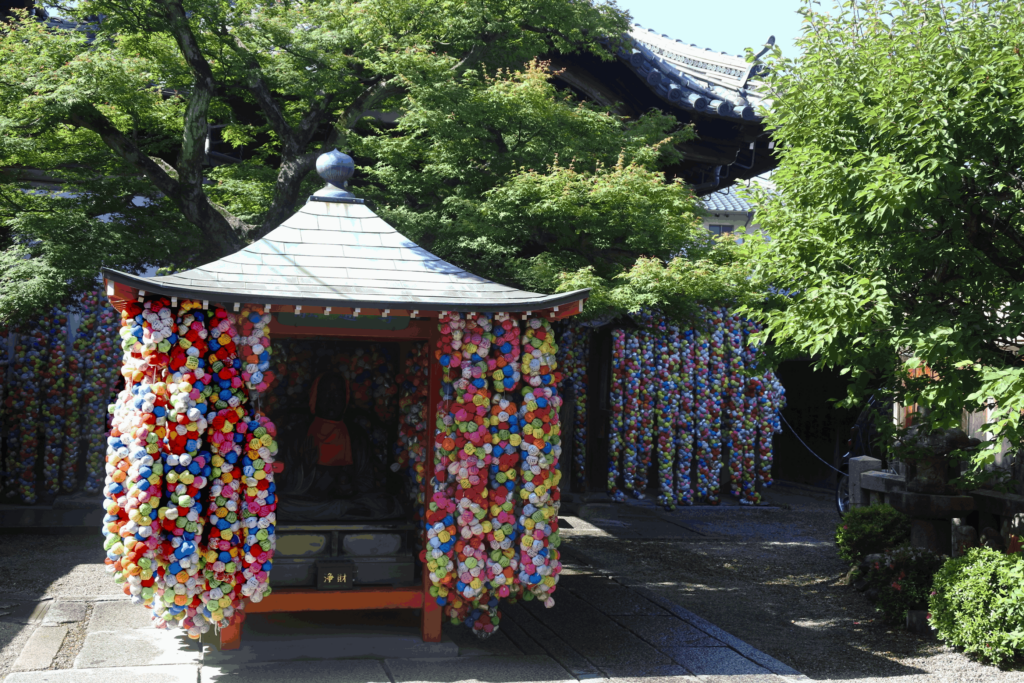


<Kongoji Temple (Yasaka Koshindo): Basic Information>
Admission: Free of charge. Prayer for Kukuri-monkeys: 500 yen per monkey
Hours: Open all year round from 9:00 AM to 5:00 PM
HP :yasakakousinndou.sakura.ne.jp/index.htm
⑥Stroll the beautiful precincts of Kodaiji Temple
This is a temple of maki-e lacquerware associated with Kitamasasho, the official wife of Toyotomi Hideyoshi, the great grand master of the Japanese imperial court. Take a stroll in the important cultural asset “Kaisando” and the beautiful Horai-style garden.
<Arrival time: 9:20 AM → End time: 10:00 AM / Duration: 40 minutes>

You can visit the temple from 9 AM. Go straight north from Kongoji Temple (Yasaka Koshindo) for about 5 minutes to reach “Nene-no-michi” and you will see the entrance to Kodaiji Temple. Within the temple grounds, you can enjoy the beauty of the important cultural properties and trees as well as the garden. A set of tickets is available for the Entokuin temple directly across the street at a discount, so visit Kodaiji Temple first. Also, don’t miss the Rishoudo Hall, which can be viewed free of charge near the entrance to Kodaiji Temple. The entire wall of the hall is painted with the image of the Reclining Buddha, which provides an experience of the Pure Land of Ultimate Bliss.

<About Kodaiji Temple>
It is a temple of the Kenninji school of the Rinzai sect, built in 1606 to pray for the repose of the souls of Hideyoshi and Nene after the death of Toyotomi Hideyoshi, the founder of the Toyotomi family. The interior decoration of the Otamaya (mausoleum) of Kodaiji Temple is decorated with maki-e, a typical Japanese lacquer-work technique in which pictures, designs, and characters are painted in Momoyama style lacquer, and gold or silver powder is sprinkled on the lacquer before it dries to fix it in place. The temple is also known as the “temple of maki-e.
Access to the temple is via a stairway leading up from Nene-no-michi, from where you can enjoy a magnificent view of the Higashiyama townscape and Houkan-ji Temple (Yasaka-no-to), the symbol of the Higashiyama area. Visitors can tour the temple as if taking a walk in a circle, enjoying the architecture of important cultural properties such as “Kaisando-Do” and “Reiya,” the neat garden, and the corridor of bamboo thickets, similar to that of Arashiyama. Higashiyama has long been a busy place with its Nigenzaka and Sannenzaka slopes, but Kodaiji Temple here is filled with a soft and calm atmosphere, which seems to reflect Nene’s personality. It is a fun way to enjoy sightseeing to visit a temple built in memory of the late Hideyoshi, and to feel Nene’s sentiments as you tour the temple. Nighttime viewing is also available depending on the season.
The small guest house, which was loved by Hideyoshi and Nene, is currently being rebuilt to commemorate the 400th anniversary of the death of Kita Masasho Nene, and is scheduled for completion in the fall of 2025.
<Kodaiji Temple: Basic Information>
Fee: 600 yen (including admission to the Palm Art Museum) / 900 yen for a discount ticket (Koudaiji, Entokuin, and Palm Art Museum)
Hours: 9:00 – 17:30 (last admission at 17:00)
Nighttime viewing is available depending on the season. During special nighttime viewing periods, viewing hours are extended.
17:00Lighting – 22:00 (Registration closes at 21:30)
⑦Experience Zen training at Entokuin Temple
This is the place where Kitamasasho Nene spent the last years of her life. Visitors can easily experience various Zen practices and enjoy matcha (powdered green tea) in the garden. Be sure to take a break as well.
<Arrival time: 10:00 AM → End time: 10:35 AM / Duration: 35 minutes>
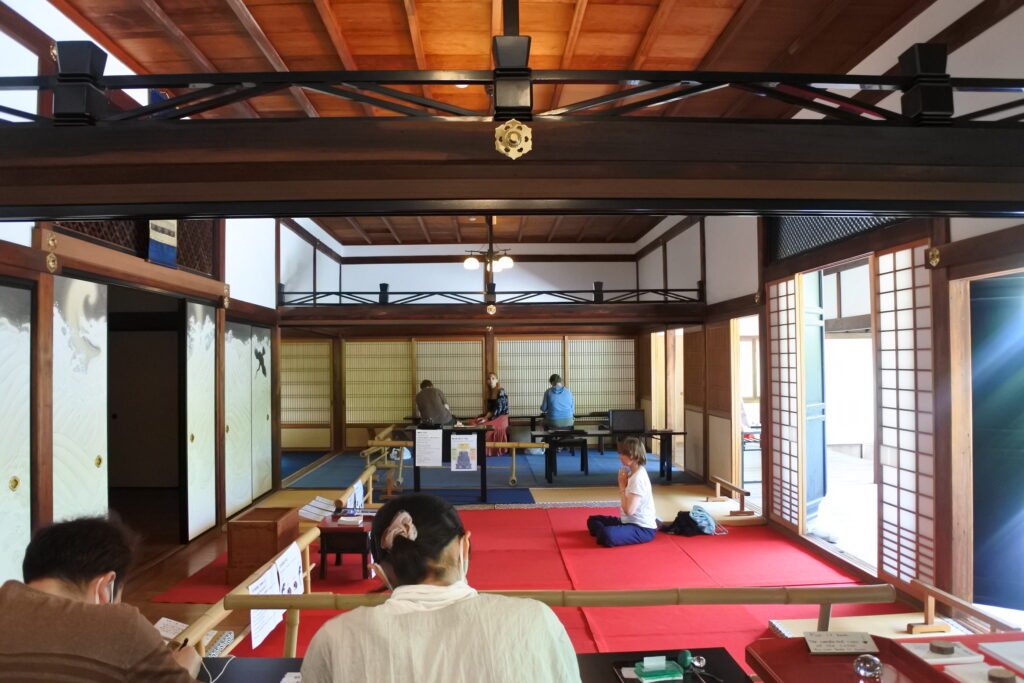
Can be viewed from 10 AM. It is located directly across the street from Kodaiji Temple, making it easy to get around. This is the place where Nene-sama died, and you can also view the beautiful garden on the premises,
The temple is also an interesting spot where visitors can enjoy a total of four activities such as “mini karesansui garden making experience,” “sutra copying experience,” and “petting Daikoku-sama” with a small kit provided, all of which are free of charge and do not require reservations. Visitors can enjoy the beautiful decorations and fusuma-e (sliding door paintings) in the temple and enjoy matcha (powdered green tea), as if they were visiting the home of Nene-sama.



<Entokuin Temple: Basic Information>
Cost: Entrance fee: 500 yen *Discounted entrance tickets are available at Kodaiji Temple (Kodaiji Temple, Entokuin Temple, and Palm Art Museum): 900 yen
Hours: 10:00 – 17:30 (last admission at 17:00)
⑧Visit Kenninji Temple to see the powerful “Twin Dragon Heads” and the National Treasure “Wind and Thunder Gods.
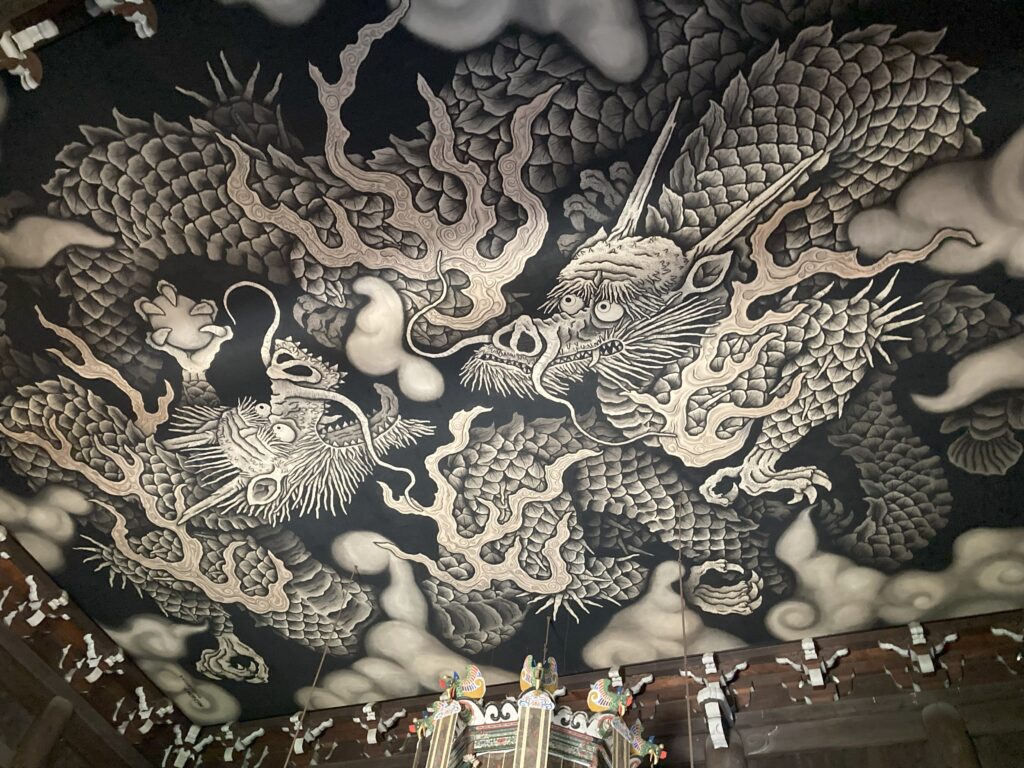
Kenninji Temple, the oldest Zen temple in Japan, was founded over 800 years ago. The temple has many folding screens and ceiling paintings, which can be enjoyed like an art museum.
<Arrival time: 10:45 AM → End time: 11:25 AM / Duration: 40-50 minutes.>
From Nenomichi, return to Yasui Konpira-gu Shrine, which you visited in (1) above, and continue westward for about 10 minutes. You will arrive at Kenninji Temple, the oldest Zen temple in Japan, where you can see the National Treasure “The Wind and Thunder Gods” and many other screen paintings such as “Unryu” (dragon and cloud paintings). The temple is different from other shrines and temples in that it has a museum-like atmosphere as you walk through the halls, including the vast Hojo and a spot where you can view the garden.
The most impressive of all is the ceiling painting “Ssangyong-zu” that fills the ceiling of the large Hodo hall. The ceiling painting, “Ssangyong-zu,” which fills the entire ceiling of the large hall, is particularly impressive and gives the illusion that a dragon has actually descended into the dimly lit hall.




<Kenninji Temple: Basic Information>
Cost: 800 yen
Hours: 10:00 – 17:00 (admission closes at 16:30)
■A shortened version of a model sightseeing course for busy people in and around Kiyomizu-dera Temple.
We introduce a shortened version of the model course for those who have difficulty with early morning sightseeing or those who do not have half a day to spare because they will also be doing other sightseeing in Kyoto. If you wish to shorten the tour, we recommend that you proceed with sightseeing while also moving around, so please refer to the following course.
①Take a city bus to Higashiyama Yasui and go to Hokanji Temple (Yasaka-no-to) (about 10 minutes including transfer)
②Go up Kiyomizu-zaka slope to Kiyomizu-dera Temple for sightseeing (40-50 min.)
③Experience praying for a monkey at Kongoji Temple (Yasaka Koshindo) (approx. 15 min.)
④Sannenzaka→Pass by Nichinenzaka and visit Yasui Konpira-gu Shrine (15 min.)
⑤Visit Kenninji Temple to see the powerful “Twin Dragon Heads” and the National Treasure “Wind and Thunder Gods” (about 1 hour including transportation)
■Eating and walking on Nichinenzaka and Sannenzaka

Most of the restaurants and cafes on Ninenzaka and Sannenzaka are [open at 10:00 or 11:00 – close at 17:00], except for “Maeda Coffee Kodaiji” and “Starbucks Kyoto Ninenzaka Yasaka Tea House”.
If you want to avoid crowds, it is recommended to visit just after opening or just before closing at 4:00 p.m.
<Model course in case of morning>
Approx. 4 to 5 hours
①Visit Yasaka-no-to (Pagoda of Yasaka) around 8:30 – 9:00 a.m. & experience praying for kuguri monkeys at Kongoji Temple (Yasaka Koshindo) (approx. 10 – 20 min.)
②Immediately after, visit Kiyomizu Temple (50 min.)
③Arrive at Nichinenzaka and Sannenzaka before 11:00 a.m. and start eating as soon as they open (about 1 hour)
④Around 12:00 p.m., go to Kodaiji Temple → Yasui Konpiragu Shrine → Kenninji Temple (your choice; 1.5 to 2 hours)
※Kiyomizu-Dera Temple is likely to be crowded after 9:00 a.m., so it is recommended to bring Kiyomizu-Dera Temple as number 1, and if you have extra time before the eating stores open, you can kill time at Starbucks or other places.
<Model course for afternoon>
Approx. 4 to 5 hours
①Sightseeing at Kenninji temple around 1:00 p.m.
②Visit Kodaiji Temple, Entokuin Temple, Kongoji Temple (Yasaka Koshindo) around 2:00 p.m.
③Sightseeing at Kiyomizu Temple around 3:00 p.m.
④Eating at Nigenzaka and Sannenzaka around 4:00 p.m.
⑤Go to Yasui Konpiragu Shrine around 5:00 – 6:00 p.m.
※Each shrine and temple closes at 5:00 p.m., so finish your sightseeing early. Yasui Konpiragu Shrine is open 24 hours a day, so you can visit in the evening or at night with no problem.

